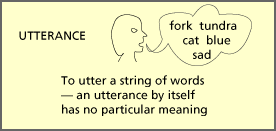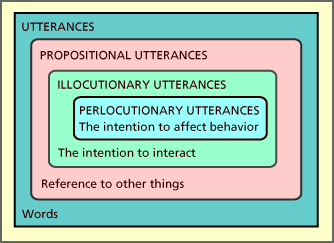

 TUTORIAL: INTERACTION AND RELATIONSHIPS
TUTORIAL: INTERACTION AND RELATIONSHIPSINTRODUCTION . NON-VERBAL COMMUNICATION . KINESICS . DISTANCE AND ARRANGEMENT . SPEECH ACTS . RELATIONSHIPS . KNOWING OTHERS . SELF-DISCLOSURE . PUNCTUATION . COORDINATED MANAGEMENT OF MEANING .
Suppose that during dinner one evening you get up, walk across the room, turn on the spigot, and pour yourself a glass of water - clearly, you performed an action. Now, suppose that you are having dinner and you ask a dinner partner to get you a glass of water. This also is an action ... the act of asking. Speech, then, is not something that just happens by coincidence. Rather, to speak is to act.
This way of thinking about speech is important because it provides insight into the utility of human communication - namely, that humans use communication as a tool to further their own ends.
One of the original scholars in this area, Searle, identifies four basic categories of speech acts as: utterances, propositional utterances, illocutionary utterances and perlocutionary utterances. These are not separate and independent of one another. Rather, they are similar to building blocks -- humans make utterances, some of which are propositional, some of which are illocutionary, and some of which are perlocutionary. The following sections present each type of speech act in turn.

For example, if you put your hand on the hood of a car that has been sitting out in the hot sun, you might quickly pull it back while uttering the word, "Oh!"
In this case, you don't intend to communicate meaning by this - it is simply a reflex action brought on by surprise. (Someone who hears you might take it mean something, but you did not plan on it.)
Examples of "pure" utterances include such as sing-song rhymes while jumping rope or making choices (as, for example, "one potato, two potato, three potato, four..."), singing "scales" for practice, and other similar meaningless expressions.
 the object to which the speaker is referring, then it becomes possible for them
to share meanings.
the object to which the speaker is referring, then it becomes possible for them
to share meanings.
Propositional utterances need not be sentences, and they do not have to intend anything. Any phrase that identifies or specifies something is a propositional utterance. It is important to see that utterances and propositions are not separate categories -- a propositional utterance is a particular kind of utterance.
 to things in the
world -- but it is their intentional nature that is of the most importance.
to things in the
world -- but it is their intentional nature that is of the most importance.
Once it becomes clear that the speaker's intention is important to the meaning of an utterance, it can be seen that the same set of words might have different meanings depending on the speaker's intention. This leads scholars to further categorize illocutionary utterances in terms of how they communicate such intent.
For example, consider the sentence: "I'm tired." Depending on the intention of the speaker, this utterance could mean any of the following:
I'm tired.
CONTEXT
|
INTENTION
|
MEANING
|
TYPE
OF ACT
|
| A
friend has just asked how I feel
|
To
answer the question
|
I
feel fatigued
|
Statement
|
| Someone
I'm trying to avoid has asked me if I'd like to go dancing tonight
|
To
politely avoid her
|
I'd
rather not
|
Statement
|
| My
husband and I are watching a football game on television
|
That
we do something else
|
Could
we turn this off?
|
Question
or Request
|
| It's
late and my small children are asking if we can go to the movies
|
To
put them to bed
|
No,
go to bed
|
Command
|
Thus, depending upon the context and the speaker's intention, a given utterance might become a statement, a command, a question, a request, a promise, and so on.
 questions, give praise, and so on, but they don't
necessarily require that the listener change his or her behavior.
Perlocutionary utterances, on the other hand, do attempt to effect a
change.
questions, give praise, and so on, but they don't
necessarily require that the listener change his or her behavior.
Perlocutionary utterances, on the other hand, do attempt to effect a
change.
As with the others, perlocutionary speech acts are utterances; they include
propositions, and they intend interaction with the receiver. Thus, Searle's model consists of a series of
levels, each of which forms as the foundation for the levels that rest upon it.
![]() 4031
4031

It is important to remember that each speech act may be followed by a return act on the part of the receiver. The next section of this tutorial will consider how communication with feedback leads to the kind of continuing communication that supports human relationships.